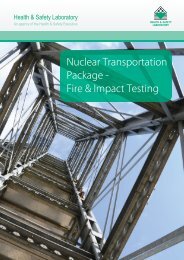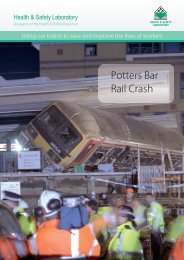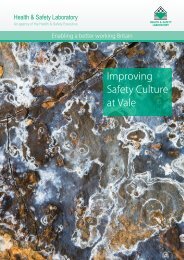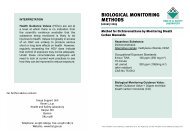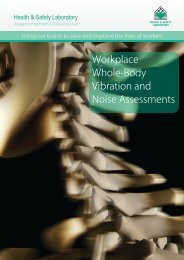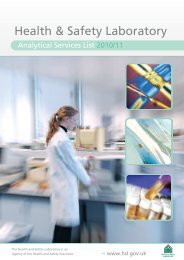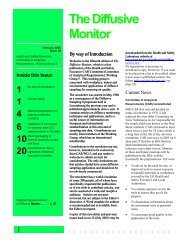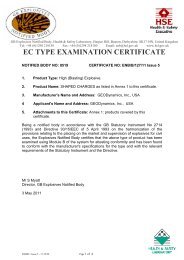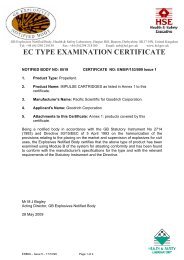London 2012 Learning Legacy Occupational Health - Health and ...
London 2012 Learning Legacy Occupational Health - Health and ...
London 2012 Learning Legacy Occupational Health - Health and ...
Create successful ePaper yourself
Turn your PDF publications into a flip-book with our unique Google optimized e-Paper software.
<strong>London</strong> <strong>2012</strong> <strong>Learning</strong> <strong>Legacy</strong><br />
<strong>Occupational</strong> <strong>Health</strong><br />
Melodie Gilbert <strong>and</strong> Dr Marianne Dyer<br />
<strong>London</strong> <strong>2012</strong> Olympic Delivery Authority
EXTENT OF THE PROBLEM<br />
HSE Statistics<br />
• 1.2 million suffer work related ill‐health<br />
• 24.6 million working days yearly<br />
• Many more than accidents<br />
– 22.1 million ill health<br />
– 4.4 million accidents
EXTENT OF THE PROBLEM<br />
HSE DRP 2007<br />
In 2006/7, for every workplace fatality there were circa ? deaths caused by<br />
occupational disease<br />
50
The ODA Business Case<br />
Arguments in the Business Case:<br />
1. Productivity –workers who are healthy, happy<br />
<strong>and</strong> here<br />
2. Recruitment <strong>and</strong> retention<br />
3. Reputational risk<br />
4. Prevention rather than litigation<br />
5. Large site, off‐site time loss kept to a minimum
The Challenge of <strong>Health</strong><br />
• <strong>Health</strong> perceived as difficult<br />
compared with other<br />
management topics<br />
– Latency ‐ causes not obvious<br />
– Interventions not perceived as<br />
easy<br />
– Reasons<br />
• Lack of information<br />
• Lack of knowledge ‐ domain<br />
of doctors <strong>and</strong> nurses<br />
– Positive outcome not<br />
immediately obvious<br />
We need to break the chain
If you always do what you have<br />
always done?...........<br />
• Outreach –go to the workplace<br />
• Mind the Gap –what’s written <strong>and</strong><br />
what’s done<br />
• Keep it simple ‐ make it easy to<br />
make the right choices<br />
• Look after the VIP<br />
• Put the health into safety <strong>and</strong> the<br />
occupational hygiene into the health<br />
...... to break the chain
The Strategy –a holistic approach<br />
Focus on the workplace<br />
• Ill–health Prevention<br />
– the impact of work on people’s health<br />
Focus on the worker<br />
• Clinical intervention<br />
– the impact of a person’s<br />
health on their work<br />
Focus on wellbeing<br />
• <strong>Health</strong> Promotion<br />
– the use of the workplace environment<br />
to promote health<br />
WORK HEALTH
WORKPLACE:<br />
<strong>Health</strong> like Safety<br />
‐ tools for the job
WORKPLACE ‐ Risks at each phase of<br />
the build<br />
• Ground Phase, Build Phase, Fit out Phase<br />
Job Roles<br />
Possible Hazards (exposures)<br />
Skin Respiratory Noise HAV MSD Biological Thermal<br />
General Operatives x x<br />
Carpenters x x x x x<br />
Control management (assessment)<br />
Noise<br />
Hazardous<br />
substance<br />
Vibration<br />
Manual<br />
h<strong>and</strong>ling<br />
Monitoring schedule<br />
Exposure<br />
Baseline <strong>Health</strong><br />
Routine <strong>Health</strong><br />
monitoring Surveillance<br />
surveillance<br />
Noise Air Vib Noise HAVs Skin Lungs Noise HAVs Skin Lungs<br />
x x x x x x x ? ? ? ?
WORKPLACE – Keep it simple<br />
•RAG systems<br />
Noise assessment was<br />
undertaken on piling<br />
operations at Team<br />
Stadium<br />
Enabling quieter<br />
operations to be carried<br />
out away from high noise<br />
levels
WORKPLACE – Baselines / Benchmarking<br />
<strong>Occupational</strong> <strong>Health</strong> Maturity Matrix (OHMM)<br />
• To show how OH is integrated with health <strong>and</strong> safety<br />
procedures.<br />
• Using interview <strong>and</strong> audit techniques <strong>and</strong> site observations<br />
• The output is a rating of between 1– 5 for each project<br />
• Implementation plans drive occupational health<br />
improvement
WORKPLACE – leading indicators<br />
• <strong>Occupational</strong> <strong>Health</strong> Impacts Frequency Rate (HIFR)<br />
– AFR = safety, EIR = environment, <strong>Health</strong>?<br />
– <strong>Health</strong> impacts –not near miss/not accident or incident?<br />
Fatality<br />
Reported occupational illness<br />
Signs or symptoms of OH ill health<br />
HEALTH IMPACTS
HEALTH<br />
THE REAL WORLD
WORKER:<br />
The success of on site clinical<br />
support
Clinical Interventions<br />
• Identification <strong>and</strong> treatment of pre‐existing<br />
disease<br />
• <strong>Health</strong> surveillance <strong>and</strong> protecting individual’s<br />
health<br />
• Rapid <strong>and</strong> effective treatment of illness <strong>and</strong> injury<br />
whilst on the Park<br />
• Improving workers’ health for the future
Fit For Work<br />
• Pre‐ employment screening of workforce<br />
• Safety Critical Medicals<br />
• Enabling people to start work, fit <strong>and</strong> safe to do so
Safety Critical Medicals
<strong>Health</strong> Surveillance<br />
• HAVS, Noise, Skin, Lung<br />
• Bespoke – contaminated l<strong>and</strong><br />
• Accessible to all employers<br />
• Assisting them to meet their legal<br />
requirements<br />
• Increased underst<strong>and</strong>ing amongst<br />
workforce<br />
• Training of skin monitors <strong>and</strong><br />
Tier 2 HAVS assessors
Clinical services<br />
• Walk in treatment service for<br />
minor injuries <strong>and</strong> ailments<br />
• Physiotherapy services<br />
• Specialist clinics<br />
• Drug <strong>and</strong> Alcohol testing
Treatment Service – Impact on Local<br />
NHS Resources
Emergency Response<br />
• Dialogue with blue light services<br />
begins prior to arrival of medical<br />
team on site <strong>and</strong> continues<br />
throughout the project<br />
• Early liaison with contractors<br />
• Coordinated site wide response<br />
• Nurses with A&E skills <strong>and</strong><br />
training for the workforce.<br />
• Only 25% of all site call outs<br />
referred to LAS
Workplace Defibrillator Programme<br />
• Number of deaths from cardiac arrests estimated to be 6<br />
during the project<br />
• Research shows that each extra minute delay reduces survival<br />
rates by 17%<br />
• Workplace defibrillator –in conjunction with LAS training<br />
given to 65 first aiders in venues difficult to reach<br />
• 13 additional defibrillators on site<br />
• 6 cardiac arrests occurred<br />
• 1/3 cases successfully resuscitated<br />
• (<strong>London</strong> 15.2%, rest of UK
Effect Of Treatment Services on the Project
Drug & Alcohol Testing Programme<br />
• Why<br />
– Safety critical nature of work<br />
– PTS work<br />
– Safety culture<br />
– REPUTATION<br />
• Contractual Requirement<br />
• For Cause <strong>and</strong> R<strong>and</strong>om Testing (5‐10%)<br />
• ZERO TOLERANCE
Effectiveness of Programme<br />
• Reduced positives from 21% to
Well‐Being<br />
Being:<br />
Engaging Workers
The Workforce<br />
• Predominantly male, average age<br />
37<br />
• Migrant workers<br />
• Poor lifestyles<br />
• Poor contact with <strong>Health</strong> Care<br />
providers, NHS etc.<br />
• Small companies/self employed<br />
without benefits packages<br />
‐ if they don’t work they don’t get<br />
paid
WELLBEING –<br />
<strong>Health</strong> Promotion<br />
• Work <strong>and</strong> Non-Work Related<br />
• Engaging workers<br />
• Site surgeries<br />
• National campaigns<br />
• Linked to safety issues
COST BENEFIT ANALYSIS ‐ IES<br />
• For the clinical service:<br />
• A simple return on investment calculation shows that (if all services<br />
would have been provided off‐site in the same way that they were on site)<br />
for every one pound invested by the ODA the return was £3.46 in reduced<br />
wages <strong>and</strong> £5.96 in reduced production costs.<br />
• For the preventative service:<br />
• Based on case studies –A return on investment of from £65 for<br />
every £1 spent up to £238 for every £1 spent.<br />
•<br />
• If we look at reduced sickness absence: for every £1 invested by the<br />
ODA in the OH service, there was a return of £7.27 in reduced<br />
production costs.<br />
•
PRACTICAL APPLICATION TO THE<br />
CONSTRUCTION INDUSTRY<br />
• Scalable<br />
• Adjusting for size, priorities <strong>and</strong> budgets<br />
• Flexible approach <strong>and</strong> demonstration of benefits
Summary<br />
• Define what good looks like ‐ health like safety<br />
• Worker, workplace, wellbeing<br />
• Reactive <strong>and</strong> proactive intervention<br />
• Risk management drives the process<br />
• <strong>Health</strong> surveillance is a monitoring tool not a solution in itself<br />
• Simple outputs that empower the supply chain to make the right choices<br />
• RAG maps for contaminated l<strong>and</strong><br />
• Noise target for piling<br />
• Traffic lights for healthy substitution<br />
• Strategy that st<strong>and</strong>s up to scrutiny<br />
• Evidence based<br />
• HIFR<br />
• <strong>Health</strong> Maturity Matrix<br />
• IES independent Evaluation<br />
• Scalable <strong>and</strong> Affordable ‐ not one size fits all<br />
http://learninglegacy.london<strong>2012</strong>.com/themes/health‐<strong>and</strong>‐safety
Thank you<br />
The official Emblem of the <strong>London</strong> Organising Committee of the Olympic Games<br />
<strong>and</strong> Paralympic text goes Games hereLtd is protected by copyright. © <strong>London</strong> Organising Committee<br />
of the Olympic Games <strong>and</strong> Paralympic Games Ltd 2007. All rights reserved.





